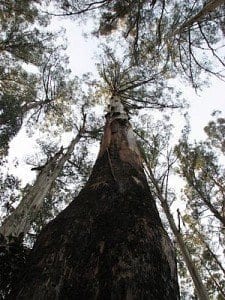The largest living organisms on the planet, the big, old trees that harbour and sustain countless birds and other wildlife, are dying.
A report by three of the world’s leading ecologists in today’s issue of the journal Science warns of an alarming increase in deathrates among trees 100-300 years old in many of the world’s forests, woodlands, savannahs, farming areas and even in cities.
“It’s a worldwide problem and appears to be happening in most types of forest,” says lead author Professor David Lindenmayer of the ARC Centre of Excellence for Environmental Decisions (CEED) and Australian National University.
“Large old trees are critical in many natural and human-dominated environments. Studies of ecosystems around the world suggest populations of these trees are declining rapidly,” he and colleagues Professor Bill Laurance of James Cook University, Australia, and Professor Jerry Franklin of Washington University, USA, say in their Science report.
“Research is urgently needed to identify the causes of rapid losses of large old trees and strategies for improved management. Without… policy changes, large old trees will diminish or disappear in many ecosystems, leading to losses of their associated biota and ecosystem functions.”
Prof. Lindenmayer says they were first tipped off to the loss of big old trees while examining Swedish forestry records going back to the 1860s. Then a 30-year study of Mountain Ash (Eucalyptus regnans) forest in Australia confirmed not only that big old trees were dying en masse in forest fires, but also perishing at ten times the normal rate in non-fire years – apparently due to drought, high temperatures, logging and other causes.
Looking round the world, the scientists found similar trends at all latitudes, in California’s Yosemite National Park, on the African savannahs, in the rainforests of Brazil, the temperate forests of Europe and the boreal forests of the far north. Losses of large trees were also pronounced in agricultural landscapes and even cities, where people make efforts to preserve them.
“It is a very, very disturbing trend. We are talking about the loss of the biggest living organisms on the planet, of the largest flowering plants on the planet, of organisms that play a key role in regulating and enriching our world,” says Professor Bill Laurance of James Cook University.
“Large old trees play critical ecological roles. They provide nesting or sheltering cavities for up to 30% of all birds and animals in some ecosystems. They store huge amounts of carbon. They recycle soil nutrients, create rich patches for other life to thrive in, and influence the flow of water within landscapes and the local climate.
“Big trees supply abundant food for numerous animals in the form of fruits, flowers, foliage and nectar. Their hollows offer nests and shelter for birds and animals like Australia’s endangered Leadbeater’s Possum (Gymnobelideus leadbeateri) – and their loss could mean extinction for such creatures.
“In agricultural landscapes, large old trees can be focal points for vegetation restoration; they help connect the landscape by acting as stepping stones for many animals that disperse seeds and pollen,” he says.
The alarming decline in old trees in so many types of forest appears to be driven by a combination of forces, including land clearing, agricultural practices, man-made changes in fire regimes, logging and timber gathering, insect attack and rapid climatic changes, says Prof. Jerry Franklin.
via Australian Research Council Centre of Excellence for Environmental Decision (ARC CEED)
The Latest Streaming News: Big trees are dying updated minute-by-minute
Bookmark this page and come back often
Latest NEWS
Latest VIDEO








